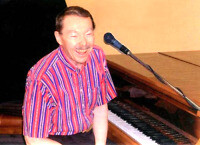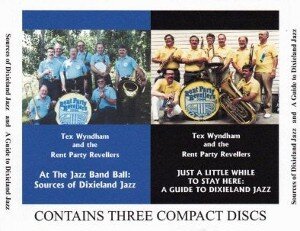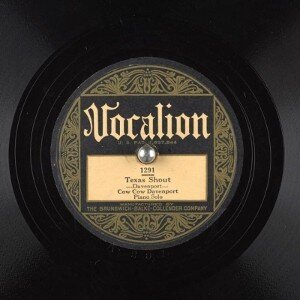 Set forth below is the sixty-third “Texas Shout” column. The first installment of a two-part essay, it first appeared in the July 1995 issue of West Coast Rag. The following introduction was added to a reprint that ran in the August 2003 issue of The American Rag.
Set forth below is the sixty-third “Texas Shout” column. The first installment of a two-part essay, it first appeared in the July 1995 issue of West Coast Rag. The following introduction was added to a reprint that ran in the August 2003 issue of The American Rag.
Because the text has not been updated, I should mention, with respect to the opening remarks in the article, that the situation has reversed in the time since the column was published. The number of older-style jazz festivals is starting to decline and the number of festivals desiring to book Dixieland bands from outside of their regions has fallen off sharply due to a steadily decreasing audience for the music and steeply increasing air fares.
Moreover, some of the big-name Dixieland bands of 1995 have reorganized or disbanded due to changes in their aging musicians’ health and personal lives. Finally, the number of festival-quality Dixieland bands formed since 1995 is close to zero.
A lot has been written in recent years, some of it in this column, about the effects on the scene of the aging audience for Dixieland jazz. Relatively little note has been taken of the fact that the same thing is happening to the musicians.
I want to talk today about the way the graying of the Dixieland musicians’ pool is affecting festivals, repertoire and recordings. To orient you properly for this discussion, I’d like you to start by taking a minute to ponder a couple of questions.
First, make a written or mental list of your personal choices as the top rank of the organized Dixieland bands. Specifically, I mean those bands which you like so much that, to see them in person, you will leave your home town for a weekend and spend some $500-$1,000 per couple (assuming you drive and stay at a hotel; it’ll be more if you have board a plane to get there).
We are talking about Dixieland here, so only list Dixieland combos. Do not include the country, blues, swing, etc., bands that are on the festival circuit, no matter how popular they are and no matter how much you like them.
My guess is that you will write about thirty names on your list, give or take a few. Nancy and I wound up with twenty-five. Everyone’s picks will be different, but I’ll bet that a core group of something like twenty bands will appear on most people’s lists.
Now count the names from the East Coast. The total will probably be close to a third of your basic throwdown. We had eight, plus another five from cities located on the Mississippi River. You’ll likely be left with somewhere between one to two dozen bands in the two U.S. western time zones.
Now go back to your original list and break it down another way. This time, note the bands that have been in existence ten years or less. You’ll see just a handful. We had only five.
What conclusion can you draw from this exercise? For one thing, you’ll observe that, during the last decade, the number of top-rank bands has not increased at a rate anywhere near matching the proliferation of festivals that desire to book top-rank names. We have more festivals chasing pretty much the same small bunch of combos.
(This situation does not affect a regional festival – one that annually hires those bands which operate in its geographic area for a weekend get-together. Regional festivals are primarily interested in putting on the same show each year for their neighbors and are not looking to draw many fans from long distances. Nothing at all wrong with doing so, of course – everyone has a good time without too much expense and the Dixieland torch is kept burning in the vicinity.)
The large multi-stage national festivals are still pretty much concentrated within shouting distance of the West Coast. (Can anyone tell me why? I’ve never been able to figure that out to my satisfaction.) Thus, the situation of many festivals chasing the same small number of bands is even worse than it appears at first. That’s because importing a band from a distant time zone involves the expense of not only air fare, but also, depending on the starting and ending times of the festival, an additional night or two in the hotel for the sidemen.
Only a few festivals have been able to bring several bands across the country at one time and still stay afloat. More commonly, the lineup sports just one or two distant bands as headliners, with the bill fleshed out by groups from the same or an adjacent time zone.
We are seeing fewer even of this second, less broad-based, type of festival. I know of three West Coast weekends that used to hire one East Coast band each year but (probably due to air fare increases) seem, as of now, to have stopped doing so. There may be others.
Thus, for many West Coast festivals, instead of chasing the thirty or so bands on your initial list, they’re really chasing the twenty or so top outfits in the two Western time zones. Is it any wonder that, from time to time in “The Letter Drop” column, we see complaints from fans about festivals hiring the same bands all the time?
Unfortunately, those letter-writers are absolutely right. Even worse, there really isn’t anything, given the current limited availability of sure-fire top-draw bands, that can be done about it.
I’m sure all festival producers would love to hire a whole bunch of those fine but more remote units that haven’t yet been seen on their stages. However, if they can’t do so without putting their festivals in financial peril, they won’t – and they shouldn’t.
But, you ask, couldn’t the lineups be shored up by a more varied mix of second-rank bands? My guess is that this procedure is being followed already, but you don’t really notice it because the second-rank bands aren’t ones that particularly attract you to attend the festival in the first place – although you’re perfectly happy to be entertained by them for a set or two once you’re there.
As an aside, I’ll mention another factor relevant to that point. To be sure, there are a few second-rank bands that are clearly on their way up. My observation, though, based on decades of reviewing records and attending festivals, is that the gap in ability between the top-rank and the second-rank bands has become very wide and is getting wider.
With many of today’s second-tier groups, including some well-known and popular ones, I find that I’ve heard everything they’re going to say after just a few tunes. However, this is a subject for a different column, one that I probably will never write because the topic is too depressing for me to contemplate at much length.
At any rate, if you took a trip last month to see a festival featuring bands A, B and C, and you’re feeling less than enthused about the prospect of making another this month to see bands B, C and D, and you think you probably will save the money next month because that one’s starring bands A, C and D, there’s really no point in getting all hot under the collar about the situation. It comes with the territory on the festival scene these days because, as with the audience, new blood is not entering the Dixieland musicians’ pool at the rate it used to 40-50 years ago.
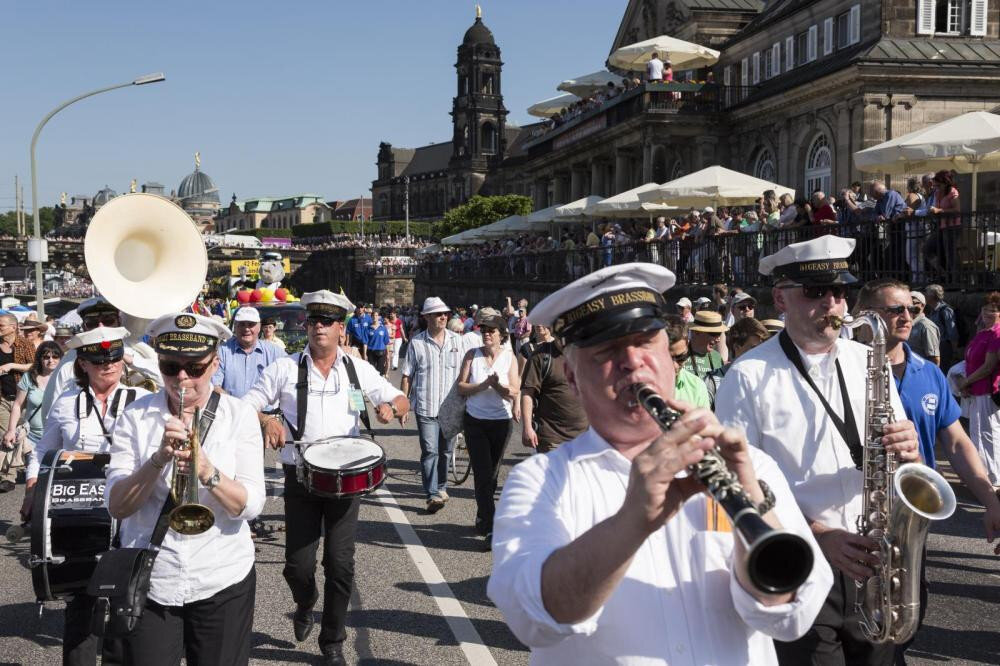
Now let’s talk about the repertoire and recordings. If, over the past 20 or so years, we had been getting the same number of young jazzers coming to Dixieland as in the 1940s and 1950s, what tunes would they be playing?
A fair number of those musicians would have learned the music the way Dixielanders of my generation did. They’d have heard a broad range of the basic recordings in the field and assimilated the standard repertoire.
At least some of them would have continued to feature the tried-and-true evergreens in their live shows and recordings. Further, those recordings would, given the vitality of youth, contain a full measure of the heat and swing that not only are the essence of jazz, but are the characteristics that brought most of us to jazz in the first place.
Instead, where are we today? Let me give you some examples.
Not so long ago, I was talking over administrative details with an official of a festival that had hired The Rent Party Revellers. As we discussed the upcoming weekend schedule, I happened to mention that the Revellers like to balance our sets, covering both standards and seldom-heard compositions. We’re just as likely to render “Nagasaki,” “I Got Rhythm” or “China Boy,” for example, as “The Yankee Doodle Blues,” “I Got A Misery” and “Brown-Skin Mama.”
I was somewhat surprised to hear a sigh of relief over the phone. The official said that, after discussions with his festivals’ board of directors, he’d been asked to talk to a few bands. He’d been planning to include the Revellers because he suspected we’d be receptive to his request. Boiled down to its essentials, he was hoping to find at least a few bands who would promise to play, during the weekend, some tunes that the folks in the audience would know.
It turned out that the festival’s chairman, a Dixieland player of wide experience over several decades, had recently been in a band that shared a concert with a nationally-known well-traveled combo. The other band’s program consisted entirely of selections that the chairman not only didn’t know, but had never heard of.
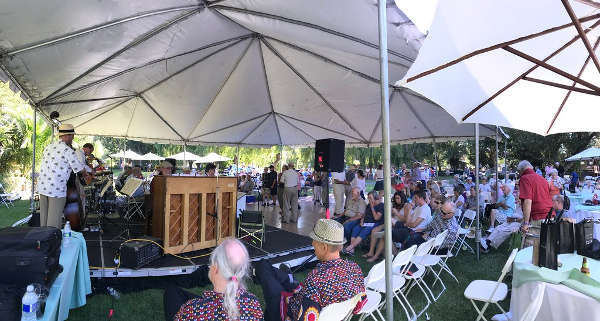
By contrast, the chairman’s band rendered a mixture of familiar and offbeat numbers. He couldn’t help noticing that the tunes receiving the loudest applause were the standards performed by his group.
His festival is fairly large, one that can’t be sustained by the dwindling number of hard-core Dixieland buffs. It must draw heavily from the general public in the surrounding area to stay solvent.
He recognized something that too many Dixielanders have chosen to ignore in recent years; no matter what else we may do, our first priority must be to entertain the audience. If the crowd wants to hear some tunes it recognizes, something that will make our music more accessible to non-Dixielanders, then we are fools (especially in this declining market for Dixieland) not to accommodate its perfectly reasonable desire. Hence, the chairman sent out the word to ask the musicians to help the audience have a good time by programming at least a few bits of reasonably familiar material.
Note that no special requests for any specific titles were made. No one was asked to wear costumes, parade through the audience, play the trombone with a foot, or do anything that might make a performer uncomfortable – except for those performers who have the odd notion that the expectations of paying customers have to take second place to their own agendas.
I can’t help noticing that this festival is one that hires Igor’s Jazz Cowboys with some frequency and that, whatever else you may think of Igor’s music, if you can squeeze your way into his packed venues, you will hear a program containing a significant percentage of tunes that strike a responsive chord in a general audience. Can it be that Igor does, indeed, have something important to teach revivalist Dixielanders? While you ponder that point, let’s cite a couple of other incidents.
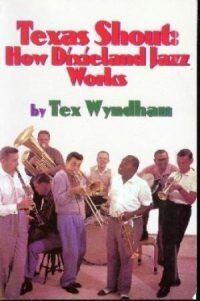 Want to read ahead? Buy the book!
Want to read ahead? Buy the book!
The full run of “Texas Shout” has been collected into a lavishly illustrated trade paperback entitled Texas Shout: How Dixieland Jazz Works. This book is available @ $20.00 plus $2.95 shipping from Tex Wyndham, On request, Tex will autograph the book and add a personalized note (be sure to tell him to whom the note should be addressed).
Tex Wyndham’s 3 CD Guide to Dixieland with music and commentary is available for $20 plus $2.95 shipping. The separate CD, A History of Ragtime: Tex Wyndham Live At Santa Rosa, is available for $13.00 plus $2.00 shipping. On request, Tex will autograph the inner sleeve and add a personalized note (be sure to tell him to whom the note should be addressed).
Send payment to Tex Wyndham, P.O. Box 831, Mendenhall, PA 19357, Phone (610) 388-6330.
Note: All links, pictures, videos or graphics accompanying the Shouts were added at the discretion of the Syncopated Times editorial staff. They did not accompany the original columns and do not necessarily reflect the opinion of Tex Wyndham.
From roughly 1970-2010, Tex Wyndham was: (1) one of the best-known revivalist Dixieland jazz musicians in the US, as cornetist, pianist and bandleader, (2) one of the best-known ragtime pianists in the US, and (3) one of the most respected critics in the US of Dixieland jazz, ragtime, and related music. He is the only person about whom all three of those statements can be made.



